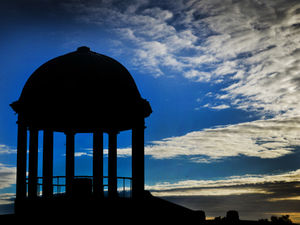Venus just one of the stunning sights in May's night skies - and don't forget The Moon
Those looking for a celestial escape from the everyday drudgery are being urged to turn their eyes skywards over the coming month.

Be it for seasoned star-watchers or amateur enthusiasts there will be plenty to amaze throughout May – using either a telescope or binoculars.
And if you're looking for a spot to gaze skywards then try the Dark Sky Discovery Sites on the Long Mynd, Carding Mill, and Elan Valley – or even Oswestry Racecourse, a spot favoured by retired Shropshire astronomer, Pete Williamson.
One of the stand-out sights is the appearance of Venus throughout the month.
Cast your eyes to the west, just after sunset and the extremely bright star will be Venus – the second planet from the sun.
An update for the month from Steve Szwajkun of Shropshire Astronomy Society, pointed to some of the highlights ahead throughout May.
He said: "While Mars and Venus enhance the western sky, the southern part of the heavens is controlled by the brilliant orange star Arcturus, in the constellation of Boötes.
"Well to its lower right you will find the bright blue-white stars Spica (Virgo) and Regulus (Leo). However the area to the left of Arcturus features only the faint stars of two giant constellation, Ophiuchus and Hercules.
"The colour of stars give some indication as to their temperature and age, with a blue-white hue indicating a young hot star whereas the older stars tend to appear orange.
"Venus continues its splendid apparition throughout May, stunning the eye as a blazing evening ‘star’, seen soon after sunset through to late evening.
"Using a small telescope you should be able to recognize its ever changing lunar-like phases. This month, Venus shifts from a gibbous phase to a near half (first quarter-like) phase.
"Saturn returns, emerging into the pre-dawn sky following its conjunction with the Sun in February. We need to wait until the later part of the month for it to climb substantially out of the horizon murk to get a better view.
"For planet searchers both Mercury and Jupiter are difficult to spot as they hug the horizon.
"There is no doubt that one of the most alluring naked-eye sights is that of a thin crescent Moon hanging low in the evening sky, set against the backdrop of a deepening blue twilight. One of the most enduring observational challenges is to hunt down the delicate thin crescent in the hours after a new moon. Not many have seen a young crescent moon less than 30 hours old.
"Those that have spotted it have likely done so serendipitously or as a result of meticulous planning, as there is a host of astronomical and environmental considerations for successful observations – good hunting!"
Mr Szwajkun also urged any budding astronomers to practice patience as they gaze towards the heavens.
He said: "When you first venture out to observe the night sky you may well be disappointed at how few stars you can see. However wait for 20 minutes and you will be amazed how much your night vision improves. The main reason for this ‘dark adaption’ is that the pupil of your eye grows larger allowing more light to enter the eye. More importantly in dark conditions the retina of your eye builds up its reserves of rhodopsin, the chemical that responds to light."
May 6 will also offer a chance to see the peak of the Eta Aquariids meteor shower but Mr Williamson, well known for his breathtaking pictures of space – from Jupiter to The Orion Nebula, encouraged people to start by just looking at The Moon.
He said: "Everyone forgets about The Moon – you do not need to be somewhere special to see that.
"I have spent a lifetime looking at The Moon through a telescope at home and I am still working my way around it. You can't miss it, you can be anywhere and you can see it."
He added: "You don't need expensive equipment, just go to a charity shop, you can get a pair of binoculars for £10 or so."
Mr Williamson said people could get their own apps on mobile phones which will help with the hobby of star spotting.
He said: "There are lots of apps you can download now for free. You point it at the sky and they show you what you are looking at.
"Just download a star map, look for the star clusters, look around with your binoculars and you will be amazed at what you can see."





